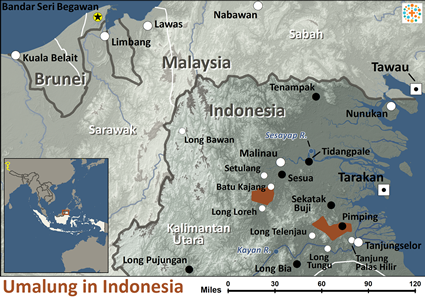The Umalung, also known as the Umalung or a subgroup of the broader North Halmaheran ethnic cluster, are an indigenous Austronesian people native to the forested interiors and coastal fringes of northern Halmahera Island in North Maluku Province, Indonesia, primarily inhabiting villages near Tobelo and the Aketajawe-Lolobata region amid volcanic lowlands and mangrove estuaries.
Their name "Umalung" derives from local dialects signifying "people of the hidden groves," reflecting their ancestral ties to secluded jungle enclaves where semi-nomadic clans forged bonds with the island's biodiversity.
As part of Halmahera's ancient Melanesian-Austronesian tapestry, the Umalung trace origins to proto-Malayo-Polynesian migrations around the 2nd millennium BCE, blending with Papuan settlers to establish autonomous settlements centered on riverine trade and spirit-mediated alliances against inter-tribal raids.
Pre-colonial society revolved around animistic kinship networks, with oral epics narrating migrations guided by ancestral shades and pacts like the Hibua Lamo—ancient covenants ensuring harmony among diverse clans amid headhunting traditions and sago rituals.
The 16th century brought Ternate Sultanate suzerainty, integrating Umalung into spice tribute systems while preserving adat governance; Portuguese and Dutch incursions followed, with VOC traders exploiting clove groves and introducing iron tools that reshaped hunting practices.
By the 19th century, missionary influences began eroding animism, though remote Umalung resisted conversion longer than coastal kin.
Post-1949 independence, they navigated Indonesian integration amid transmigration and nickel mining booms, contributing to regional resilience during the 1999-2000 Maluku conflicts, where Hibua Lamo pacts revived to mediate ethnic-religious tensions.
Today, amid national parks and resource pressures, the Umalung uphold linguistic distinctiveness in their tonal dialect, embodying Halmahera's legacy of ecological stewardship and cultural hybridity.
The Umalung navigate a verdant mosaic of jungle clearings and tidal shores on Halmahera, where seasonal monsoons and lunar cycles dictate a harmonious interplay of foraging, crafting, and communal rites, sustaining clans through adaptive ingenuity in North Maluku's wild heart.
Work pulses with forest and sea synergies, as men wield blowpipes and snares to hunt cuscus, wild pigs, and monitor lizards in understory thickets, while women harvest sago pith, weave rattan baskets, and dive for trochus shells in reef shallows; families rotate swidden plots for taro and bananas, supplemented by bartering resins and megapode eggs at Tobelo markets, though encroaching mining lures youth to wage labor in extraction camps, bridging subsistence with fragile modernity.
Family dynamics root in bilateral clans dwelling in octagonal longhouses clustered around sacred squares, where elders—adorned with shell amulets—facilitate consensus via storytelling councils, marriages weave alliances through bride-service and gong exchanges evoking ancestral voyages, and child-rearing immerses youth in tonal lullabies and spirit apprenticeships, fostering reciprocity where aunts and uncles share guardianship to mirror the clan's fluid, riverine bonds. Celebrations erupt with rhythmic fervor during dry interludes, including harvest vigils with bamboo orchestras and legong dances circling effigies to beseech forest guardians, initiation scars etched under full moons symbolizing rebirth, and inter-clan feasts blending Hibua Lamo oaths with mock raids reenacting Ternate pacts; funerals span dawns with vigils floating carved prows downstream, invoking safe passage for souls amid firelit epics.
Food harvests the isle's primal bounty in earthy, shared rituals, staples of papeda—sago gel stirred with fish broth and ferns—paired with smoked eel adobo, roasted grubs for vitality, and rare cassowary stews during rites; saps fermented into tuak elixir quench gatherings from gourd communal bowls, affirming the eternal cycle of grove and tide.
Umalungs practice ethnic religions rooted in animism, a worldview where spirits inhabit every tree, river bend, and volcanic spring, guiding daily harmony through offerings and shamanic intercessions for bountiful hunts and communal peace. This tradition permeates existence via ancestral altars in village squares, where elders invoke grove guardians for protection against raids, and tonal chants beseech sea shades during monsoons, framing nature as a living kin network demanding reciprocity. Shamans, or tohunga, mediate spirit pacts akin to Hibua Lamo, blending ecological ethics with moral taboos, while rituals emphasize balance—transgressions appeased through scarification or effigy floats—viewing life's flux as a sacred dialogue with unseen forces.
Archival transcription of Umalung oral epics and dialects through community workshops is essential to preserve tonal nuances against the encroachment of Tobelo Malay in schools and trade. Community-led patrols and legal advocacy for territorial rights in Aketajawe-Lolobata National Park would defend sago groves and hunting paths from illegal logging and mining, upholding ecological and cultural lifeways. Establishment of mobile clinics for tropical fevers and nutritional support would bolster maternal and child health in remote hamlets, enabling fuller engagement in regional economies without forsaking forest ties.
Pray for open hearts among Umalung shamans to encounter transformative visions of Christ's lordship over spirits, igniting clan-wide dialogues that honor ancestral wisdom through gospel light.
Pray against isolation's grip on animistic strongholds, fostering house gatherings where youth blend tonal chants with Scripture for intergenerational renewal.
Pray for peacebuilding extensions of Hibua Lamo pacts, opening avenues for neighboring Tobelo to share faith testimonies amid shared island heritage.
Pray for resilient reforestation initiatives safeguarding jungle corridors, yielding sustained sago and game for family larders.
Pray for youth empowerment programs weaving Umalung crafts into eco-tourism, fortifying economic bridges without eroding clan autonomy.
Scripture Prayers for the Umalung in Indonesia.
Wikipedia. "North Halmahera Regency." https://en.wikipedia.org/wiki/North_Halmahera_Regency
Wikipedia. "Tobelo people." https://en.wikipedia.org/wiki/Tobelo_people
Vendelin.org. "The Togutil of Halmahera – North Maluku, Indonesia." https://vendelin.org/travel/indonesia/north-maluku/togutil/
Wikipedia. "Togutil people." https://en.wikipedia.org/wiki/Togutil_people
ScienceDirect. "Togutil tribe's ecological hunting calendar on Halmahera Island, Indonesia." https://www.sciencedirect.com/science/article/pii/S2351989424004487
ResearchGate. "Cultural Identity of North Maluku in Folk Pop: When Traditional Meets the Future." https://www.researchgate.net/publication/377494294_Cultural_Identity_of_North_Maluku_in_Folk_Pop_When_Traditional_Meets_the_Future
Wikipedia. "Halmahera."
https://en.wikipedia.org/wiki/Halmahera
Britannica. "Halmahera."
https://www.britannica.com/place/Halmahera
Art of the Ancestors. "Maluku Art — Art of The Ancestors." https://www.artoftheancestors.com/maluku
| Profile Source: Joshua Project |

























